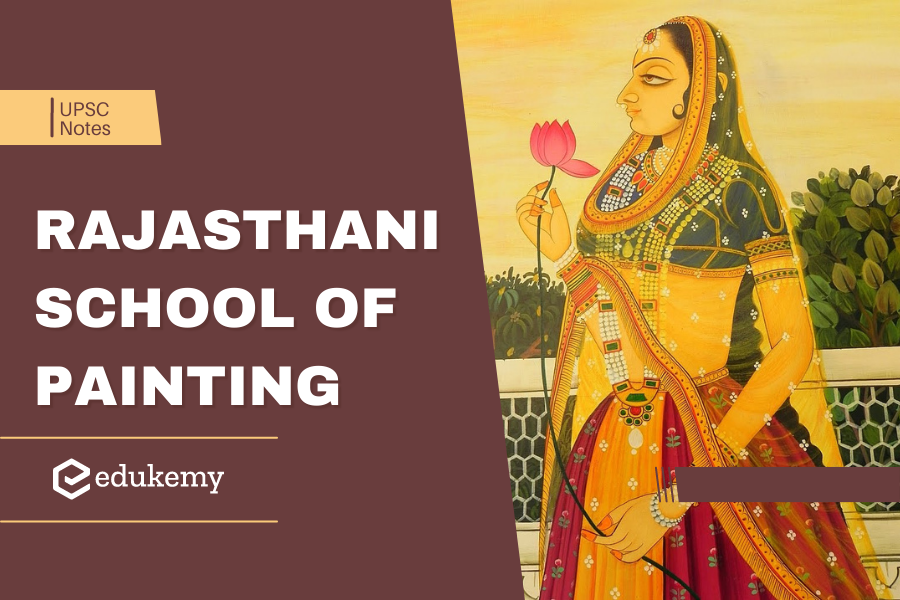The Rajasthani School of Painting, also known as Rajput painting, is a rich and diverse tradition of art that originated in the royal courts of Rajasthan, a northwestern state of India. This school of painting has a history dating back to the 16th century and has continued to flourish, producing exquisite artworks that reflect the culture, history, and aesthetics of the region. Rajasthani painting is characterized by its intricate detailing, vibrant colors, and a strong focus on depicting themes from Indian mythology, epics, and courtly life. It encompasses various sub-schools, each with its unique style, such as the Mewar School, Marwar School, and the Kishangarh School, among others.
One of the most remarkable aspects of Rajasthani painting is its ability to capture the essence of Rajasthan’s diverse landscape and culture. The artists use a variety of materials, including watercolors, tempera, and gold leaf, to create intricate miniature paintings that often adorn manuscripts, royal palaces, and temples. The portrayal of vibrant Rajasthani traditions, royal processions, and poetic expressions make this school of painting a significant cultural treasure. Rajasthani painting has not only influenced the art world but also played a pivotal role in preserving the history and traditions of Rajasthan for generations to come.
This school of painting had influence in Rajasthan and parts of Madhya Pradesh in the present time, such as Mewar, Bundi, Kota, Jaipur, Bikaner, Kishangarh, Jodhpur (Marwar), Malwa, Sirohi and other such principalities largely between the sixteenth and early nineteenth centuries.
Contents
- 1 Salient features of Rajasthani paintings
- 2 Bundi School of Painting
- 3 Malwa School of Painting
- 4 Mewar School of Painting
- 5 FAQs on Rajput Paintings
- 5.1 Q: What is Rajput painting?
- 5.2 Q: What are the main sub-schools of Rajput painting?
- 5.3 Q: What materials are typically used in Rajput painting?
- 5.4 Q: What are the common themes depicted in Rajput painting?
- 5.5 Q: How has Rajput painting contributed to Indian art and culture?
- 5.6 For Admissions, talk to our Mentor – 9811333901, 9811333782
Salient features of Rajasthani paintings
- This style of painting is deeply rooted in Indian traditions.
- The cults of Vaishnavism, Saivism, and Saktiexercised tremendous influence on the pictorial art of this school.
- Various cults of Krishna provided a very rich field to the painter who with his artistic skill and devotion made a significant contribution to the development of Indian painting.
- The Rajasthani School of Painting is marked by bold drawings and strong and contrasting colors.
- The treatment of figures is flat without any attempt to show perspective in a naturalistic manner.
- Sometimes the surface of the painting is divided into several compartments of different colours to separate one scene from another.
- Mughal influence is seen in the refining of drawings and some elements of naturalism introduced in figures and trees.
- Apart from depicting stories from the Ramayana the royal lifestyle of kings and queens was also depicted.
- They also portrayed social values and the changes introduced by kings for the betterment of society. The background of the paintings formed a special feature of the Rajasthani School.
- Paper, ivory, and silk were used as canvas in this school of painting.

Bundi School of Painting
- This style of painting is dated back to 1625 AD.
- A painting showing Bhairavi Ragini, in the Allahabad Museum is one of the earliest examples of Bundi painting.
- Themes from the life of Krishna are a major theme in this school of painting.
- An example of the above is, Rasikapriya of the late 17th century, which has a scene that represents Krishna trying to collect butter from a Gopi, but finding that the pot contains a piece of cloth and some other objects and no butter he rea1ises that he has been duped by the Gopi.
- In the background are trees and in the foreground is a river indicated with wavy lines. In the river are seen flowers and a pair of aquatic birds. The painting has a border in brilliant red color.

A salient characteristic of the Bundi School of Painting
- The salient characteristics of this school of painting are the rich and glowing colors, the rising sun in golden color, the crimson-red horizon, and overlapping and semi-naturalistic trees.
- The Mughal influence is visible in the refined drawing of the faces and an element of naturalism in the treatment of the trees. The text is written in black against yellow background on the top.
Malwa School of Painting
It flourished between 1600 and 1700 CE and is most representative of the Hindu Rajput courts. Unlike the specificity of Rajasthani schools that emerged and flourished in precise territorial kingdoms and courts of their respective kings, Malwa School defies a precise center for its origin and instead suggests a vast territory of Central India. This conservative style disappeared after the close of the 17th century.
Salient features of Malwa’s form of painting
- Malwa paintings show a fondness for rigorously flat compositions, black and chocolate-brown backgrounds, figures shown against a solid color patch, and architecture painted in a lively color.
- The school’s most appealing features are a primitive charm and a simple childlike vision.
- An illustrated version of the Rasikapriyā (1634) was the earliest work in this style, followed by a series illustrating a Sanskrit poem called the Amaru Śataka (1652).
- Additionally, there were illustrations of the musical modes (Ragamala), the Bhagavata-Puraṇa, and other Hindu devotional and literary works.

Mewar School of Painting
- The Mewar school of painting is a Rajasthani style of Indian miniature painting developed in the Hindu principality of Mewar during the 17th and 18th centuries.
- The works of this school are known for their simple bright colors and direct emotional appeal.
Salient features of Mewar School of Painting
- The earliest example of Mewar painting is a series of the Ragamala painted in 1605 CE at Chawand by Misardi, which can be found in the collection of Shri Gopi Krishna Kanoria.
- Other works in this style include illustrations of the Rasikapriyā, the Amaru Śataka, the Bhagavata-Puraṇa, and other Hindu devotional and literary works.
- One famous painting from the Malwa region of Rajasthan depicts Ravana begging Sita for alms.
- The expressive and vigorous style of Mewar painting continued with some variations through 1680, after which Mughal influence became more apparent.
- While religious themes remained popular, an increasing number of paintings focused on portraiture and the life of the ruler.


FAQs on Rajput Paintings
Q: What is Rajput painting?
A: Rajput painting, also known as Rajasthani painting, is a traditional style of Indian miniature painting that originated in the royal courts of Rajasthan. It’s characterized by its vibrant colors, intricate detailing, and a focus on depicting themes from Indian mythology, courtly life, and landscapes.
Q: What are the main sub-schools of Rajput painting?
A: Rajput painting includes several distinct sub-schools, such as the Mewar School, Marwar School, Kishangarh School, and Bundi-Kota School. Each sub-school has its unique style, color palette, and subject matter.
Q: What materials are typically used in Rajput painting?
A: Rajput artists traditionally use materials like watercolors, tempera, gold leaf, and fine brushes to create their intricate miniature paintings. They often paint on materials such as paper, silk, or ivory.
Q: What are the common themes depicted in Rajput painting?
A: Rajput painting commonly portrays themes from Hindu mythology, epic stories like the Ramayana and Mahabharata, courtly life, royal processions, and poetic expressions. The choice of themes often varies depending on the specific sub-school and the patron’s preferences.
Q: How has Rajput painting contributed to Indian art and culture?
A: Rajput painting has had a significant impact on the preservation of Indian history, culture, and traditions. It has not only enriched the art world with its unique style but also served as a valuable medium for depicting the rich heritage and lifestyle of the Rajput rulers and their courts. These paintings continue to be important cultural artifacts and sources of historical knowledge.
For UPSC Prelims Resources, Click here
For Daily Updates and Study Material:
Join our Telegram Channel – Edukemy for IAS
- 1. Learn through Videos – here
- 2. Be Exam Ready by Practicing Daily MCQs – here
- 3. Daily Newsletter – Get all your Current Affairs Covered – here
- 4. Mains Answer Writing Practice – here
Visit our YouTube Channel – here


